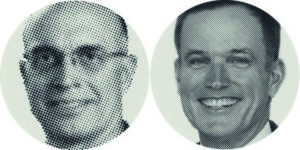
Following a year like no other comes a Vascular Annual Meeting (VAM) like no other—sort of.
This year, the key date on the vascular conference calendar features a seemingly unprecedented double header: a Presidential Address tandem.
After the cancellation of the 2020 VAM in the wake of the COVID-19 pandemic, then serving Society for Vascular Surgery (SVS) President Kim Hodgson, MD, was unable to deliver the customary presidential send-off talk. In its stead, this year VAM (Aug. 18–21; San Diego) will feature addresses from both immediate past presidents.
Ronald L. Dalman, MD, who recently handed over the SVS presidency to Ali AbuRahma, MD, and Hodgson, who served as president from 2019–2020, will take to the podium on separate days with talks that reflect on 75 years of SVS history and look ahead to where the vascular surgical specialty is headed. Yet, as Dalman points out, the incidence of two addresses at one SVS conference is not without precedent. Some 18 years ago, before the SVS merged with the American Association for Vascular Surgery (AAVS), the joint annual meeting held between the two societies included addresses from their respective presidents.
His predecessor brings this broad sweep of societal history right up to the SVS of today and pressing clinical matters currently on the leadership agenda. “If you build it, he will come,” intones the mysterious voice in the classic baseball movie Field of Dreams. But Hodgson has a slightly different take on this with respect to some important SVS initiatives. His voice would proclaim: “We built them. It’s up to you to use them.”
He’s referring to the latest additions to the SVS portfolio of Quality Improvement tools, the just-completed Appropriateness Use Criteria (AUC) on Intermittent Claudication, and the remotely monitored SVS Supervised Exercise Therapy (SVS SET) app and Vascular Center Verification and Quality Improvement Program, both nearing the end of their pilot phases.
“These are tools the SVS has developed to help members distinguish themselves from the less scrupulous actors in the space, in the case of the verification program, and to improve the outcomes and care of our patients,” Hodgson says. He was giving a preview of the Presidential Address he will deliver Thursday, Aug. 19, at VAM. “Membership now has to stand up and embrace these things and participate.”
SVS is developing a verification program for vascular surgery practices, in both the outpatient and inpatient settings. “Outside people are coming in, looking at your program, reviewing it, talking with you, interviewing your staff. It’s active quality improvement, not passive,” he said.
Of special importance is a focus on defining quality and appropriateness of care for all vascular surgeons across practice settings, but with some emphasis on practitioners working in an OBL (outpatient-based lab). OBLs as a site of service are extremely important to the future of vascular surgery. However, they are relatively unregulated for quality and appropriateness and so more open to the potential for outlier practice behavior, Hodgson added. He stressed neither he, nor the SVS, are “anti- OBL—we are pro-quality and appropriateness. If we don’t set up standards and assess ourselves, someone else surely will do it for us.”
Currently, the SVS is “in the final stage of the piloting—with six practices included—to evaluate the relevance of our standards,” he says. Hodgson also lauds SVS SET, the app that employs coaches plus tracking via phones to supervise patients with peripheral artery disease in their walking therapy, as a substitute for SET done in a medical setting. Challenges remain, including insurer reimbursement, but preliminary results are promising, says Hodgson.
The app is another tool members can use to deliver top-notch patient care, he adds. “We built this. Now it’s up to our members.”
Meanwhile, Dalman is set to use his address, set for Friday Aug. 20, to touch on the three-quarter-century-long legacy of the SVS and its antecedents. “As the 75th president, I will celebrate what the SVS has accomplished since our founding in 1946, as well as anticipating the challenges that lie ahead,” he says. “A robust and effective SVS is essential for the health and sustainability of the specialty of vascular surgery.”
His time at the podium, he explains, will outline what is going to be required to keep the SVS going strong for another 75 years. Dalman opened his presidency at the 2020 VAM digital replacement, SVS ONLINE, with a Crawford Forum focused on the existential questions in the specialty. Dalman elaborates on the broad context of the SVS. “Prior to the merger of the AAVS and SVS in 2003, the combined AAVS/SVS meeting, as VAM was then called, always included two presidential lectures,” he says. “Having two presidential addresses this year honors our history as well as acknowledging the unfortunate cancellation of VAM 2020 in Toronto.”












